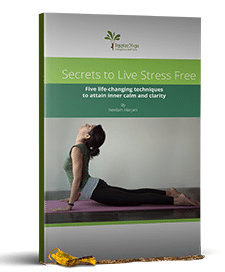From the time we enter the world to the time we leave; our breath is with us every moment. Breathing is the critical sign of vitality- however if we are not breathing correctly it can drain our energy. The breath itself can help bring life and energy to the body- that is why in yoga we treat it as the fabric of health and wellness. The human body can go 3 weeks without food, 10 days without water but only 3 minutes without breathing- our breath is our most important source of energy. In yoga, breathwork is called Pranayama, Prana means energy, so these breathing exercises facilitate the movement of energy.
Stress causes tension and tightness around the neck and shoulders, affecting our posture to slouch which restricts our breathing. The full contraction and relaxation of muscles is thwarted causing the volume of the chest cavity to increase and decrease to a much smaller proportion than their capacity. The result? The breath becomes shallow and short, to compensate for the smaller volume of air exchanged the body compensates by breathing more frequently to receive the same amount of oxygen compared with breathing deeply and slowly. This becomes taxing on the body and starts to deplete our energy. Just notice how you have been breathing as you read this book, now sit up straight, slow down and breathe deeply- can you feel your entire torso participate with each breath?
There are 3 centers of breathing for a full breath, first the chest, second the ribcage and third the abdomen. As you breathe in feel the sternum lift, then the ribs flare out and finally the navel expand outwards. As you breathe out the order reverses; first bringing the navel inwards, the ribs narrow together, and the sternum drops. Are you able to access these 3 centers with your resting breath? Most of us only breathe into the chest or the ribcage this puts more load around the upper back and shoulders as it supports the breathing which isn’t their primary function. Meanwhile we bypass abdominal breathing which employs the diaphragm to contract and relax to its full capacity serving its primarily role to support the ventilation process. Abdominal breathing releases endorphins which stimulate a relaxed state when we pay attention of the soothing and calming rhythm of full, deep and slow breathing. If you have ever seen a baby sleep you would have noticed the gentle rise and fall of the baby’s belly, we start out connecting and trusting the body’s natural most efficient rhythms. Stress and mental agitation disrupts these rhythms bringing imbalance and creating dissonance from the body away from the most efficient pathways.
Chronic stress causes a long-term tightening around the chest which creates a habit of shallow breathing that keeps us in a state of tension. Consciously bringing your body to energetically be involved in the breathing process to activate the 3 centers will help to reestablish the natural, relaxed patterns of breathing. As you actively feel the chest, ribcage and abdomen take part in the breathing process let your mind slow down and be conscious of the full expansion as you inhale and the full contraction as you exhale- with just a few active conscious breaths you will feel a marked difference in the established relaxing rhythm of your breathing pattern.
Corresponding to our energy the inhalations are activating, and the exhalations are relaxing- the same way our diaphragm and intercostal muscles engage to inhale and release to exhale. To balance our energy, it should take the same amount of time to breathe in as it does to breathe out in regular intervals, check with yourself- are your inhalations and exhalations even? When the emphasis falls on the inhalation we may be experiencing an agitated level of stress causing anxiety, insomnia and hypertension. On the contrary when the exhalation is more pronounced we may be experiencing a draining stress causing lethargy, lack of motivation and a dullness in our energy.
As a tip to become more mindful to how our body responds to stress, check your breathing patterns when your mind is restless, you will quickly see the relationship of stress on your energy, body and breathing.
- Where in your body is the breath most concentrated?
- Is the breath in or the breath out more dominant?
- Is the left nostril or the right nostril more open?
A study by Ravinder Jerath in 2006 published by the US National Library of Medicine showed that breathing techniques from yoga (pranayama) improved the immune function, hypertension, asthma, autonomic nervous system imbalances and stress related disorders. The results of breathing deeply and slowly with mental awareness conclusively linked breathing techniques to stress reduction and the enhancement of psychological functioning. How come breathing techniques help with mental and physical states? The breath acts as a bridge connecting body and mind, when we bring our attention on breathing rhythms we are physically and mindfully experiencing the pranayama, feeling calm in the body and clear in the mind. As we begin to consciously feel the body respond to each inhalation and each exhalation our thoughts are suspended causing the active experience to feel relaxed and focused.
For the full analysis download our free e-book here “Secrets to Live Stress Free”

